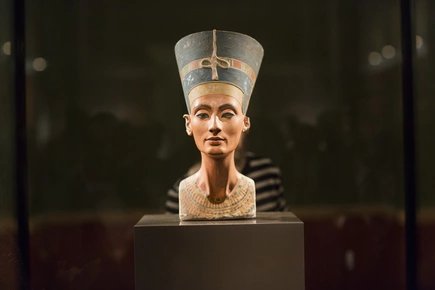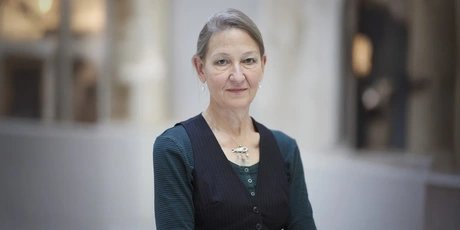
Friederike Seyfried, Director of the Ägyptisches Museum
My favourite piece from the collections
The ram from Gebel Barkal
Among the many personal favourites in the collection entrusted to me, it is hard to decide which object to give preference to. Of course, in addition to many smaller, rather inconspicuous objects, the famous exhibits such as The Green Head, The Small Portrait Head of Queen Teje or The Bust of Nefertiti are among my favourites, but classics of ancient Egyptian literature, including the Life of Sinuhe or the Life of the Weary, which are kept in the Niobid Hall of the Neues Museum, should also be mentioned.
Well-travelled
A particular favourite piece, however, is the large ram from Gebel Barkal, which has been on prominent display again in the Neues Museum in the Greek Court since August 2022. The travelling history of the ram is remarkable: created around 1356 BC in Soleb in Lower Nubia (approx. 500 km south of Aswan), it was brought from there around 600 years later to a temple at Gebel Barkal in Napata, from where it was shipped to Berlin for the Neues Museum in 1845. In recent decades, the ram has been on permanent loan to Hildesheim for space reasons and returned to Berlin in 2022 after a final flying visit to the Louvre.

A ram as the embodiment of the god Amun-Re and the pharaoh
This monumental ram represents a symbiotic embodiment of the creator and sun god Amun-Re and his deified founder, Pharaoh Amenophis III. (1388 - 1350 BC) and was originally placed in pairs along the road to the temple of Soleb (Sudan) alongside 11 other examples, 4 monumental falcon statues and 2 lion statues.
Masterpiece of craftsmanship
The theological stroke of genius successfully realised in this statue and its implications for science are already reason enough for experts to appreciate it, but the masterpiece of craftsmanship should be honoured here first and foremost. With a skilful feel for the characteristics that define a full-grown ram, the artist has created this 2.3-tonne image from grey granite and reproduced all important features in great detail. This is particularly successful in the rear view, which reveals that the ram is resting completely naturally and relaxed on its right hind flank. Divinity and naturalness have found a wonderful unity here.
Prof. Dr. Friederike Seyfried
